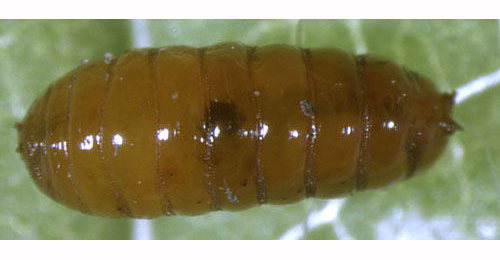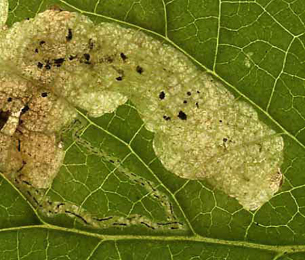|
||||||
|
GALEOPSIS. Hemp-nettles. [Lamiaceae] |
|
Six species of Galeopsis are recorded in Britain. These include the native species Bifid Hemp-nettle (G. bifida), Red Hemp-nettle (G. angustifolia), Downy Hemp-nettle (G. segetum), Large-flowered Hemp-nettle (G. speciosa) and Common Hemp-nettle (G. tetrahit) and the introduced Broad-leaved Hemp-nettle (G. ladanum). Eight British miners are recorded on Galeopsis. A key to the European miners recorded on Galeopsis is provided in Bladmineerders van Europa. |
Key for the identification of the known mines of British |
||
1a > Stem miner: A shallow, inconspicuous external stem mine. Pupation in stem near a node (Spencer, 1972b: 29). |
||
|
||
Ophiomyia labiatarum Hering, 1937 [Diptera: Agromyzidae]. |
||
1b > Leaf miner |
||
2a > Leaf-miner: A distinctive mine primarily above mid-rib, with irregular short lateral offshoots into leaf blade. Pupation external (Spencer, 1972: 51 (fig. 172), 55; Spencer, 1976: 270, 271 (fig. 486)). Branched, whitish, upper-surface corridor; main axis overlying the midrib; side branches overlying the main lateral veins. (In Campanula and Phyteuma the mine is much less branched, sometimes nothing more than a corridor on top of the midrib). Frass in rather long strings. Usually the mines begins as a long and narrow, shallow, tortuous lower-surface corridor that ends upon the midrib but otherwise is not associated with the leaf venation. Often this initial corridor is filled with callus, and then even less conspicuous. Pupation outside the mine. A linear mine on the upper surface, usually following the midrib and showing side branches along the veins. The frass is in strings. |
||
|
||
|
||
Liriomyza strigata (Meigen, 1830) [Diptera: Agromyzidae]. |
||
| 2b > Leaf-miner: Mine not primarily associated with mid-rib. | ||
3a > Leaf-miner: A linear-blotch mine, first instar mine is linear, later developing into a conspicuous white blotch. Frass greenish diffused (Spencer, 1972b: 46, 47 (fig. 138); Spencer, 1976: 166). The mine begins with a long, upper-surface, slender corridor. After a moult the larva changes its behaviour, and makes a large, upper-surface primary blotch without apparent feeding lines. Often the blotch overruns more or less the initial corridor. Frass in the corridor liquified to form a wide green band, with a few tiny black granules along the sides. Pupation outside the mine. A narrow gallery leading to a largish blotch on the upper surface. Frass is green and indistinct in the gallery - small grains may be seen at the gallery edge. |
||
 Amauromyza labiatarum puparium Image: © Willem Ellis (Bladmineerders van Europa) |
||
|
||
Amauromyza labiatarum (Hendel, 1920) [Diptera: Agromyzidae]. |
||
3b > Leaf-miner: Initially a long, slim corridor, the frass alternating on either the side of the corridor. After moulting, the larva broadens the mine and the frass is less regular. Pupation external. |
||
 Mine of Amauromyza lamii on Stachys sylvatica Image: © Willem Ellis (Bladmineerders van Europa) |
||
|
||
Amauromyza lamii (Kaltenbach, 1858) [Diptera: Agromyzidae]. |
||
3c > Leaf-miner: An initially linear mine, which at second instar develops into a large whitish blotch with conspicuous black frass. The early linear mine is frequently entirely enveloped by the blotch but is detectable by the alternate irregular strips of frass. Pupation external (Spencer, 1976: 158). The first part of the mine consists of a long, slender upper-surface corridor. After the first moult this changes into a large primary blotch without feeding lines. Frass in the corridor in short, somewhat angular thread fragments, towards the end even in grains. Frass arranged less closely along the sides than in A. lamii. Pupation outside the mine. The frass is conspicuous in the mine and the mine is initially linear, then develops into a white blotch, often enveloping this early mine. |
||
|
||
Amauromyza morionella (Zetterstedt, 1848) [Diptera: Agromyzidae]. |
||
3d > Leaf-miner: Mine linear, whitish, both upper and lower surface. Pupation internal, at the end of the mine with the anterior spiracles projecting through the epidermis (Spencer, 1976: 433). Upper-surface, less often lower-surface corridor. Frass in isolated grains. Pupation within the mine, usually in a lower-surface puparial chamber. A long whitish upper surface corridor, which eventually goes lower surface. |
||
|
||
Chromatomyia horticola (Goureau, 1851) [Diptera: Agromyzidae]. |
||
3e > Leaf-miner: A linear mine commencing with a conspicuous regular spiral and then continuing a considerable distance more or less straight (Spencer, 1976: 245). Upper-surface corridor. The first part is wound in a dense spiral that quickly turns brown. The spiral continues in a long, generally unbranched corridor that maintains almost the same width. Frass in long thick strings. When the mine is positioned near the leaf margin the spiral part may be missing; the thick frass strings then are sufficiently characteristic. Pupation outside the mine; exit slit in lower epidermis. Long upper surface gallery starting with a spiral of 6 to 8 turns (as shown). Frass in conspicuous narrow linear lines. |
||
|
||
Liriomyza eupatorii (Kaltenbach, 1873) [Diptera: Agromyzidae]. |
||
3f > Leaf-miner: A short, irregular, linear upper surface mine on any part of the leaf. Puparium pale yellowish brown |
||
|
||
Liriomyza bryoniae (Kaltenbach, 1858) [Diptera: Agromyzidae]. |
||
3g > Leaf-miner: Rather long full depth corridor that winds freely through the leaf and may cross itself. In the end the corridor widens considerably. Frass mostly in a narrow central line, but may also be deposited along the sides or be missing. The larvae regular leave a mine to restart elsewhere. Pupation outside the mine. Neither larva or mine can be distinguished from that of related species. |
||
|
||
Apteropeda orbiculata (Marsham, 1802) [Coleoptera: Chrysomelidae]. |
||
| Last updated 09-Jul-2020 Brian Pitkin | ||

